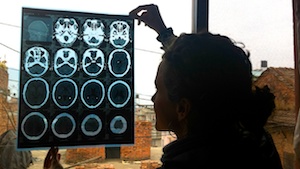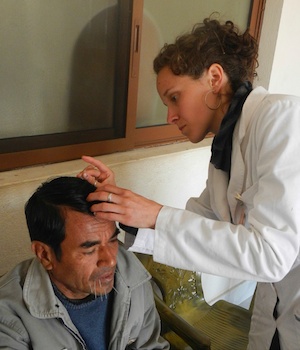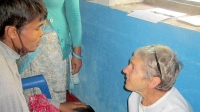Emma Goulart LAc
February 2013
OVERVIEW
 60-year-old male presents with sudden onset of motor deficit of right hand, tingling and weakness of right foot, as well as marked changes in function of glossopharyngeal and hypoglossal nerve. Within the course of 15 acupuncture treatments, including electric stimulation and moxibustion, there are marked improvements in motor function testing of right hand, a decrease in sensation of tingling and pain in right foot, reduced pain in the ball of right foot and a cessation of headaches.
60-year-old male presents with sudden onset of motor deficit of right hand, tingling and weakness of right foot, as well as marked changes in function of glossopharyngeal and hypoglossal nerve. Within the course of 15 acupuncture treatments, including electric stimulation and moxibustion, there are marked improvements in motor function testing of right hand, a decrease in sensation of tingling and pain in right foot, reduced pain in the ball of right foot and a cessation of headaches.
Subjective
Patient is a 60-year-old male who presents with compromised motor function in right upper limb. The onset of symptoms started 7 months ago, reaching maximal deficit over a half hour period, affecting the right upper and lower limbs. There is suspected glossopharyngeal and hypoglossal nerve involvement due to changes in throat and tongue function.
At his hospital visit, he was diagnosed with left-sided ischemic stroke, prescribed 6 different medications, as well as shown several physiotherapy exercises to do at home.
Prior to his stroke, he had no symptoms of dizziness, pain in the chest, nausea or vomiting, nor any other abnormal signs. Patient was actively being treated for hypertension prior to stroke. The patient is mostly concerned about his right hand, since it is preventing him from being able to work. Most of his frustration is due to the loss of control of movement in his right hand. He also mentions right leg weakness and slight tingling and pain on the dorsal aspect of the foot. Further questioning reveals the feeling of weakness is caused by painful knotting on the ball of his foot.
Since the incident he has had more difficulty speaking, which he describes as a tickle in the back of his throat. This sensation in his throat came on during the stroke along with the loss of motor function in his right hand. He notes short-term memory impairments since the incident, described as an inability to remember details.
Patient is currently taking 4 medications: Amlodipine, Clonazepam, Aspirin and Atorvastatin.
Bowel movements are formed, but feel incomplete and are difficult to pass. Normally he passes stool daily, though he can go up to 3 days without a bowel movement. Patient reports scanty urination. He sleeps through the night, usually getting between 7 and 9 hours per night. He reports feeling cold inside, especially on fingers and toes. He does not perspire, no matter the level of exertion. He experiences occipital headaches regularly, and relates them to his high blood pressure. His eyes burn and feel irritated.
OBJECTIVE
 Patients overall health is above average for age and environmental factors. He appears strong constitutionally, with a demeanor that is generally quiet. He seems hopeful of the acupuncture treatments and open to any way in which he can participate in the process, including a dedication to coming for treatment daily.
Patients overall health is above average for age and environmental factors. He appears strong constitutionally, with a demeanor that is generally quiet. He seems hopeful of the acupuncture treatments and open to any way in which he can participate in the process, including a dedication to coming for treatment daily.
Hospital records from June 2012 (7 months prior to treatments), are from 3 weeks after the incident. A CT scan was administered, showing evidence suggesting ischemic stroke. The carotid doppler report was normal, as was lipid testing. The color doppler echocardiography report showed aortic valve and mitral valve thickening. The mitral regurgitation grade was II-III. The tricuspid regurgitation grade was II. Fair left ventricular systolic and diastolic function. Right upper limb testing showed flaccid tone, power of 0/5 and hyper reflexion. However, all other limbs received normal scores.
Upon arrival to our clinic, several tests are undergone to assess patient.
Facial testing: Sharp/dull test: No clear findings along trigeminal nerve pathway; He is able to feel light touch bilaterally on face, though sharp/dull testing is inconsistent along his right side. Facial nerve testing is inconclusive. Expressions are all normal. He is able to raise his eyebrows, close his eyes and grimace. However, his smile appears slightly slanted down on right side.
Glossopharyngeal nerve testing is inconclusive. Speech is normal when saying O, La and Cha, though he has trouble saying E. Patient is constantly clearing his throat while talking, and has asked for water on multiple occasions due to dryness.
Hypoglossal nerve deficit is positive with a deviated tongue.
Right Upper Limb:
Sharp/dull test: Shows sensory deficit distal to wrist joint. Patient is unable to distinguish between sharp and dull in this area.
Full AROM in both shoulder and elbow joints bilaterally. On the affected side, his wrist function is compromised with extension at 30 degrees and flexion at 70 degrees. Additionally, 1st to 4th fingers slant 30 degrees laterally.
Isolated finger extension: 0/5 in 3rd to 5th digits, with no movement at all; 2/5 in 1st and 2nd digits, with minimal movement, but not against gravity;Isolated finger flexion - 3/5 in all fingers with movement against gravity, but not against resistance Grip strength is roughly 30% weaker on the right side; Wiggling fingers - 3/5
Vitals: Blood pressure is 160/90.
TCM: Tongue is deviated, overall sticky white coat, yellow at root; Scalloped edges with red body on sides
Pulse on right is thin and wiry. Left is full and surging, but weak in chi position.
ASSESSMENT
DX: CT scan taken 3 weeks after incident shows evidence of left ischemic CVA. These medical results, combined with a decrease in motor function of upper right limb, and a notable change in throat and memory impairments, meet criteria to confirm diagnosis given by hospital of left ischemic CVA with right hemiparesis.
TCM DX: Blood stasis pattern causing blockage of channels and collaterals resulting in internal wind; Underlying Liver yin deficiency causing Liver yang to rise
PROGNOSIS: At initial consultation, patient had already regained motor and sensory deficits since his hospital visit 7 months prior. Due to these changes, combined with patient’s strong constitution and dedication to physiotherapy exercises, further recovery seems promising. It is hopeful that acupuncture and physiotherapy exercises will continue to aid successful management of motor and sensory deficits, though full neurological recovery may not be possible.
PLAN
Treatment principles: Move blood stasis, open channels and collaterals, and nourish the Liver yin.
Treat with acupuncture 6 days per week for 10 treatments before full reassessment. Long-term treatment, however, is likely needed 3 days per week. Treatment approach is to open right-sided Yangming and Shaoyang channels, unblock qi and blood in collaterals. Scalp points along primary motor cortex on left side to stimulate right-sided motor function, occasionally with electric stimulation. Local points on right side around affected area of mouth and throat to stimulate affected nerve pathways.
Typical treatment: Bilateral treatment: LI4, LV3, DU26, REN23, REN24, DU15, DU16; Right-sided: GB34, Ba Xie and Ba Feng, electric stimulation between LI12 and LI4, LI11 and SJ3, UB60 and LV3, GB40 and GB43. Needling along the motor cortex line on left side of head, roughly between DU20 and GB6. Most treatments consist of stick moxa along his right metacarpalphalangeal joints to open blockage in channels and collaterals.
Additional physiotherapy and coordination exercises are provided for at-home treatments: Making a fist and opening it for motor function, touching thumb to each finger to improve coordinated motor function and touching hands behind back and above head for proprioception. Patient is sent with a moxibustion stick to use for warming the Yangming and Shaoyang channels on his right hand.
OUTCOME
The patient came almost every day that the clinic was open for 4 weeks, even though his home is an hour and a half away. There was significant visible progress, over the 4 weeks of acupuncture treatment and physiotherapy exercises, of the motor function in his right hand.
After the 2nd treatment, he reported an increased ability in moving his right fingers, noticeable while getting dressed and tying his shoes.
After the 8th treatment, during our 2nd week, there was marked improvement in isolated finger extension. He presented at 4/5 rating on all digits except the 4th, having the ability to maintain position against gravity and against minimal applied resistance. His 4th digit, at 2/5, was unable to move against gravity. This was a great improvement from 0/5 on his first visit to the clinic 2 weeks earlier. Additional new testing was done on his 8th visit. Touching each finger to thumb - movement was slow, though possible on all fingers except his thumb to 5th digit.
At treatment 10, a reassessment of sharp/dull testing on the affected hand was normal, aside from his 1st finger, which had unclear results, showing some areas with lack of sensory function. This was an improvement from his 1st visit, which showed sensory deficit distal to wrist joint. Overall, he felt that there had been improvements in movement of fingers. His main concerns at our re-evaluation were his persistent headache and the stiffness he feels in fingers of affected hand.
At treatment 15, patient felt positive about his hand, though he noted swelling in his 3rd and 4th digit at 2nd interphalangeal joints. The area of tingling on his right foot had decreased by 50%, and the pain on the ball of his foot was intermittent. Testing touching thumb to fingers was the same as our testing at treatment 8, with an inability to touch thumb to 5th digit.
CONCLUSION
Patient sought acupuncture 7 months after his stroke and within 15 treatments saw marked improvement in motor function of his right hand, as well as further sensory function in right foot. His headaches subsided within the last 3 treatments. The patient was advised to come 3 times per week for another month, with the hope of continuing to improve motor function. This will hopefully maintain a slow and steady improvement, aiding in his recovery. It is unclear whether the acupuncture will allow full recovery of motor function of his right hand. However, it can certainly be a means for managing the deficits caused by the stroke.











